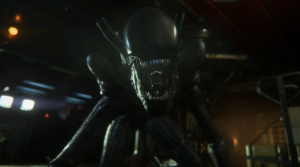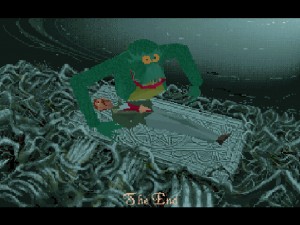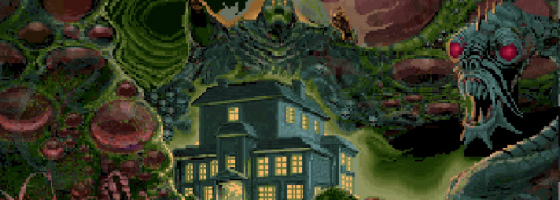In a previous post on Game-Wisdom, I talked about why the jumpscare-focused horror titles today don’t interest me, and in that post I mentioned how first generation horror titles don’t seem to be popular today.
As I thought about it, there was something special about games like Resident Evil and Alone in the Dark despite the technological and design constraints of the day. Even more interesting, some of these elements even found their way into my dream horror title that I wrote a design doc for.
Generations of Terror:
It’s weird talking about the Horror genre in the sense of generations, but it has seen radical shifts in design and philosophy for over two decades. When I think of Horror as a genre for video games, there are three categories/generations that come to mind.
We have the recent jumpscare-focused or passive interaction style of games like Slenderman, Five Nights at Freddy’s and Amnesia. Earlier than that, there are the action-focused or action-horror seen in titles like Dead Space, Alan Wake, Alien Isolation and Resident Evil 4. Finally we have the older horror games that borrowed from the adventure genre: Resident Evil, Fatal Frame, Clock Tower and of course Alone in the Dark.
Each generation has a different focus on design and gameplay; lending to the different appeal by fans. Jumpscare-based or passive horror tends to focus on storytelling and mood at the expense of gameplay.
These games tend to either hit big or disappear fairly quickly from the market. Both Amnesia and Five Nights have become major successes for delivering a “less is more” kind of experience.
Action-horror games tend to give the player a lot of control over the character and obviously are the most action-heavy of the three generations.
In these games, exploration and puzzle solving is usually downplayed in favor of assaulting the player with all manner of monsters. While the player is free to run away from enemies, most of the time it’s better for them to just kill them outright.

Action-horror gives the player a lot of means of fighting back, but has trouble sustaining the horror over long periods of time
Getting the balance between making the player powerful and still delivering fear is the hardest part of these games, and where many designers slip up.
Alien Isolation came the closest with delivering an antagonist that the player could just not win against, but even that had trouble with pacing.
The problem with action-horror is that a horror experience is not meant to be a long game, but action games generally strive for 5 to 10 hours of solid gameplay.
Finally we have the first generation, and where I want to spend the focus of this post on. For those that didn’t grow up then, horror games were originally an offshoot of the adventure genre; which at the time was also known for putting the player in life or death situations.
What horror did differently was put an active threat against the player instead of simply living or dying from puzzles. When it comes to discussing horror and what made the first generation so special, we have to talk about Alone in the Dark and what it did differently.
Home Away from Home:
Alone in the Dark is considered by many to be the first actual example of a Horror title, and the inclusion of adventure game elements can be seen. Alone in the Dark (or ATD for the rest of this post) was a non linear game. Instead of guiding the player around, they were free to roam around the manor to find clues and items needed to solve puzzles. The puzzles in ATD were of two kinds: Those that were about getting around an obstacle or door, and those for dealing with a specific enemy.
Unlike older adventure games, ATD did have a combat system built around close and ranged fighting. The enemies of the game were split between common enemies like zombies, and specialty enemies like the knight and ghosts. Common enemies could be fought with any weapon, while specialty enemies required the player to figure out how to deal with them.

The first generation of horror combined the designs of adventure and action to deliver unique (and terrifying experiences)
What I enjoyed about ATD was that feeling of exploration; not following a set path like in action-horror titles.
Because of the adventure style, there were far less enemies in ATD compared to the action-horror genre, and this gave them a larger presence.
Enemies that were built around puzzle solving were also more interesting compared to enemies of other horror games; you just couldn’t fill them full of ammo to get rid of them.
Another point that made ATD special was that the split between puzzle solving, exploration and combat, kept the player’s own sense of power constantly fluctuating based on what was going on.
Depending on where the player was in the manor, they could be feeling powerful after dealing with enemies, or scared by some strange new sight or incident.
In most action-horror games, new enemy types are rarely introduced, in favor of overwhelming the player with regular enemies. Even when something new is added it’s either a boss enemy that is a onetime fight, or it’s just another enemy that can be killed.
The same issue can also be said of jump-scare or passive horror games. In this case, the player’s own means of interacting with the game are so limited, that it doesn’t matter what the designer comes up with when the player only has one or two ways of dealing with any situation.
To be fair, the game Haunting Ground had a similar idea of having the player being chased by several antagonists with no real way of stopping them, but the game was built around balancing exploration and puzzle solving with avoiding the threats.
Old School Terror:
I would love to see game designers look to the older adventure horror games as a source of inspiration for modern horror titles. That feeling of being alone and the effective pacing of build up and release, works better with older designs compared to jump-scare and action-horror. I have not been excited for a horror game in a long time, and hopefully someone will be able to make a horror game to actually scare me.
If you haven’t had a chance, you can check out the design doc I started to write for my horror idea on Game-Wisdom; that would be one of my dream ideas to make someday.
Thanks for reading the post, if you enjoyed it, please consider donating to the Patreon Campaign. Every donation helps keep the site ad-free and allows me to put out more great content.


